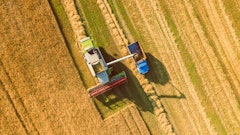
Decarbonization of off-highway equipment is being driven by environmental regulations, the pursuit of lower operating costs, and growing societal expectations for sustainable practices. Electrified equipment also offers added benefits, such as noise reduction — an important factor for construction machinery used in urban environments. However, progress toward electrification in the agricultural and construction equipment sectors has been limited so far and is expected to remain relatively low through 2030.
Demonstrator vehicles for electric agricultural tractors have been showcased in recent years, but their challenges have become increasingly apparent. Compact tractors, typically used for landscaping or light-duty farm tasks, often operate for less than five hours a day. These limited operating hours, coupled with their low power demands, reduce the required battery capacity — keeping battery costs low (see Figure 1). However, the low operating costs of these machines also make it difficult to justify the investment in electrification from a business perspective.
 Figure 1. Biobased-diesel feedstocksRoland Berger
Figure 1. Biobased-diesel feedstocksRoland Berger
Utility tractors, which are one size up, operate for much longer periods (8–10 hours per day) and require significantly more power. Consequently, battery capacity — and battery weight — increases substantially. In extreme cases the battery could double the weight of the vehicle. Large, high-horsepower tractors, which often operate for up to 12 hours a day on large farms pulling heavy equipment, require even larger batteries. This added weight can cause greater soil compaction, which negatively impacts soil aeration and crop yields, limiting the viability of electrification for these machines.
In the construction equipment segment, mini excavators are more suitable for electrification. These machines are commonly used in urban areas where the reduction of emissions and noise is highly beneficial, and they can be charged using standard power supplies. Many equipment manufacturers already offer electric mini excavators. However, larger excavators face similar electrification hurdles: increased battery weight and cost, and challenges related to charging at remote jobsites. That said, larger excavators are good candidates for hybridization. For instance, energy recovery from boom swing movements can improve fuel efficiency and extend operating time, boosting equipment utilization.
As the limitations of full electrification become clearer, the off-highway industry is increasingly exploring alternative decarbonization pathways. Biomass-based diesel fuels — such as biodiesel and renewable diesel — offer a promising solution for hard-to-electrify segments like agriculture and construction.
Although engines capable of running on pure biodiesel (B100) are already in use, the current production of biomass-based diesel falls far short of what’s needed to meet demand across all hard-to-abate sectors. While U.S. production of these fuels has grown significantly over the past decade, adoption remains largely driven by policy. Without incentives such as California’s Low Carbon Fuel Standard (LCFS), biomass-based diesel is not cost-competitive with fossil diesel. As a result, its market remains mostly confined to LCFS-compliant states like California.
The biomass-based diesel market is also highly sensitive to policy changes. For example, when the EPA’s Renewable Fuel Standard (RFS) set the 2023–2025 biodiesel volume targets below the industry’s production capacity, some production plants were underutilized or shut down entirely.
 Figure 2. Electrification potential of tractors
Figure 2. Electrification potential of tractors
Despite these challenges, biomass-based diesel has already become an important demand driver for U.S. farm output — especially soybeans, with nearly half of U.S. soybean oil now going into biomass-based diesel production (see Figure 2). As exports decline due to new tariffs and shrinking global demand, domestic biomass diesel could offer a crucial market for U.S. soybean farmers. In the long run, biodiesel and renewable diesel production could both support the decarbonization of farm equipment and serve as a valuable income stream for American agriculture.
![Hcm Ax Landcros Press Release[32] jpg](https://img.oemoffhighway.com/mindful/acbm/workspaces/default/uploads/2025/11/hcmaxlandcros-press-release32jpg.mAEgsolr89.jpg?auto=format%2Ccompress&fit=crop&h=100&q=70&w=100)







![Hcm Ax Landcros Press Release[32] jpg](https://img.oemoffhighway.com/mindful/acbm/workspaces/default/uploads/2025/11/hcmaxlandcros-press-release32jpg.mAEgsolr89.jpg?ar=16%3A9&auto=format%2Ccompress&fit=crop&h=135&q=70&w=240)









